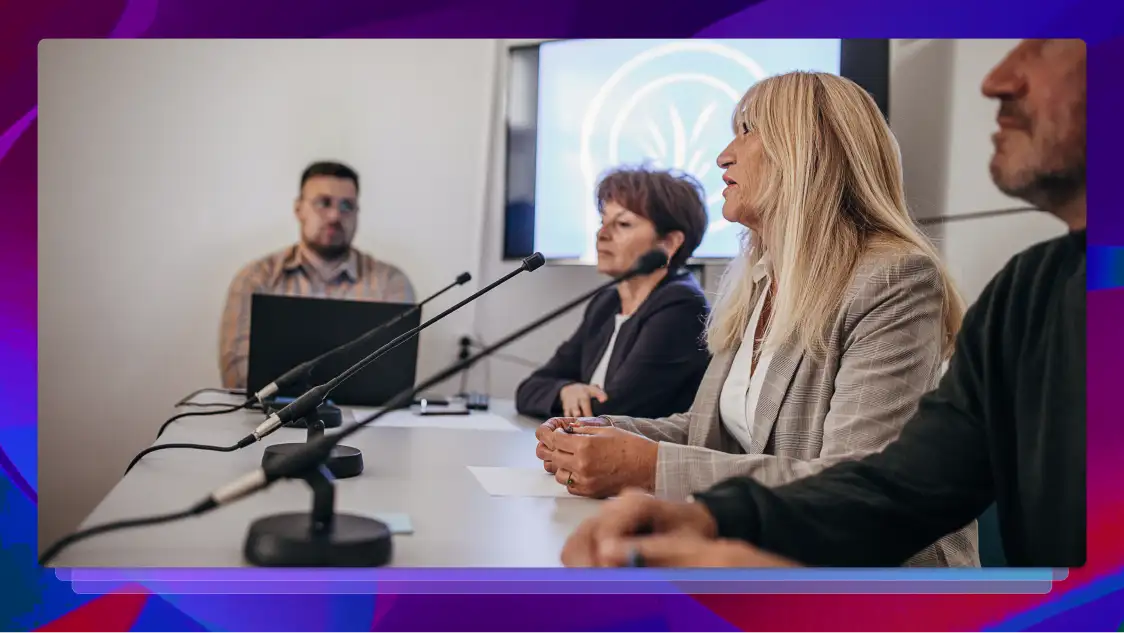How to: Video Editing Dialogue Sequences Faster in the Post-Production Process
Here's some tips for video editing dialogue sequences faster: organization, source syncing, use waveforms, low playback quality, and get audio transcripts.

Whether you’re cutting your breakout feature film, editing interviews, or compiling 30-second web testimonials, you’ve probably found out by now that editing dialogue can be a chore. You can speed up the process, though, by making a few small adjustments to your post-production workflow.
How do you edit dialogue faster in the post-production process?
- Get Organized
Naming conventions go a long way.
- Sync All Your Sources
You never know which mic you’re gonna need.
- Utilize Waveforms
Cut the silence visually.
- Reduce Playback Quality
No need for high-quality scrubbing, man.
- Get Audio Transcripts
Search your footage like Google.
- Focus on the Edit
Don’t skip ahead to color correction.
1. Get Organized
Before you even open a video editor, start by making sure your files are well organized and clearly named. You can even do this during production.
Match your audio and video files by naming them with the date and descriptors that remind you what they are. For example, “9-26-19-ElmerFuddInterview-Video.mp4” and “9-26-19-ElmerFuddInterview-Audio-Lavalier.wav”.
You can further organize files into folders, perhaps by location, scene or interviewee. Do whatever makes the most sense to you and keeps you from spending time investigating what’s what.
2. Sync All Your Sources
Once you do import audio and video into your favorite video editor, start by syncing audio and video sources first. If you’ve named your files well, then syncing every video source to its corresponding audio should be a snap.
If your camera has an onboard mic, use it in production. Now you’ve got backup audio and something for your editing software to use for auto-sync (if it has that feature).
If you’ve recorded multiple mics, be sure to sync those as well, even if you don’t plan on using them. That way you don’t find yourself searching for an alternate source if there’s a problem with your main source. Sync all of your takes and make synced clips that you can drop into your final edit as one unit, so you only have to sync once.
Just as with your source files, name your new clips appropriately, and organize them in a way that makes sense to you. Using bins that match your original folder system can be handy, as can putting synced timelines into their own separate bins.
3. Utilize Waveforms
Once your sources are all nicely synced, make sure to turn on the waveform view, so that you can see waveforms. This will make it much faster to find silence to cut and to tell whether there’s an issue like a dropout or a clip, and where slate markers are.
If you have large clips with multiple takes, you can easily see where one take one ends and the next begins by looking at the waveform, and you can make new clips for each take. You’ll also be able to see false starts and skip those. Of course, when in doubt, you should listen too.
At this point, it’s wise to make new clips for each take; and it’s faster if you don’t bother to go through an entire clip looking for things to delete. Rather, simply find each take, make a clip and move on, leaving your original synced clip intact.
If you’re a visual learner, you can check out this helpful video on editing dialogue using waveforms.
4. Reduce Your Playback Quality
Unless you’re using a professional-quality, 4k ready computer (and who is?) to edit video, you may have noticed how slow it can be to queue up or scrub through clips. However, even on the best machines, it’s not necessary to view an edit at the highest resolution.
In fact, especially when you’re editing audio, it may hardly even be necessary to look at the video at all. So, decrease your playback quality temporarily.
Try using the proxy method to create smaller files, and also view them at half or quarter resolution during playback. You’ll avoid long load times, freezing, jittering and lag that comes with rendering full-resolution video.
While you’re at it, you may want to allocate more of your CPU resources to your edit software, and if you edit on a platform like Davinci Resolve, it will utilize your GPU for video, leaving more processing power for audio.
5. Use Audio Transcription
In documentaries and news, using a written transcript to find the juiciest sound bites while editing interviews has been the standard of practice since the beginning. In the interest of efficiency, you might consider using this method. You can put together your entire edit on paper before cutting video, and this will definitely speed things up.
You could transcribe audio yourself or hire an intern, or you could get Rev to do it for you. You’ll be able to mark important timecodes and easily find and highlight important passages. Rev can even make captions that you can look at in your editor to easily scrub to the pieces you’re looking for once you’re editing.
To save some money (Rev costs $1 per video minute), consider waiting to send out for your transcript until after you’ve taken separated takes and cut out silence, or even when you’ve got a few takes eliminated. This way Rev isn’t scrubbing through silence and outtakes, and you get the added benefit of having separated transcripts for each take or section. It’s up to you how to organize it all; the important part is to keep things making sense to you.
6. Focus Only On The Edit
Once you’re really well organized and ready to actually cut together your edit, focus entirely on that and not sound mixing and sweetening. Don’t bother with effects or music cues or balance at this point, just edit your dialogue.
The only “mixing” you might consider doing during or just before the editing phase is to bring up your volume levels to a decent level. This will also help with transcription. It’s advisable to do this in the timeline while you’re syncing sources, rather than in the sound mix window, so that this rough change carries through to new clips and timelines. Once you’ve got your dialog brought up to a decent, relatively even level, you can save the rest of the mixing for later.
Of course, once you do start the mix, you can use a variety of effects and tools to your advantage. EQ can help you clean up noise or correct differences between takes and interviews. You can also use a high pass filter to get rumble out of a take that’s especially bass-heavy. Compression is a good tool for evening out high and low volume levels, and it’s common to use some compression on narration or interview tracks. You can EQ before or after your compression stage. Which is better depends on your preference and goals, but in general EQing before compression tends to create a warmer, rounder tone, and EQing after is good for clarity.
Other tools you may consider include de-essing (taming the “s” sounds in speech), noise reduction or even creative use of delay and reverb. We’ll dive into sound mixing for video more in a future article.
In The End
At the end of the day, you need to be able to achieve quality results efficiently, and how you manage your workflow is key to managing your time well. As a reminder, here are some points to remember when you sit down for your next edit session:
- Organize your files – organize and name audio and video files to eliminate searching
- Sync first – get your audio and video sources synced up before you do anything else
- Use waveforms – use the visual reference of a waveform to find silence and new takes faster
- Reduce video quality – you don’t have to render 4k video during the dialogue edit
- Try audio transcription – using a written transcript can speed an edit up significantly, and is easy to do with a service like Rev
- Focus on the edit – finish your edit before you dig into sound mixing and enhancements
If you haven’t already implemented these techniques in your edits, try them in your next session. You should see real improvement to your speed and maybe even your sanity!
Subscribe to The Rev Blog
Sign up to get Rev content delivered straight to your inbox.



